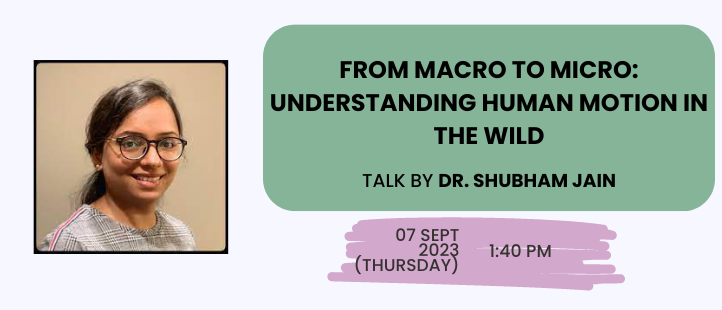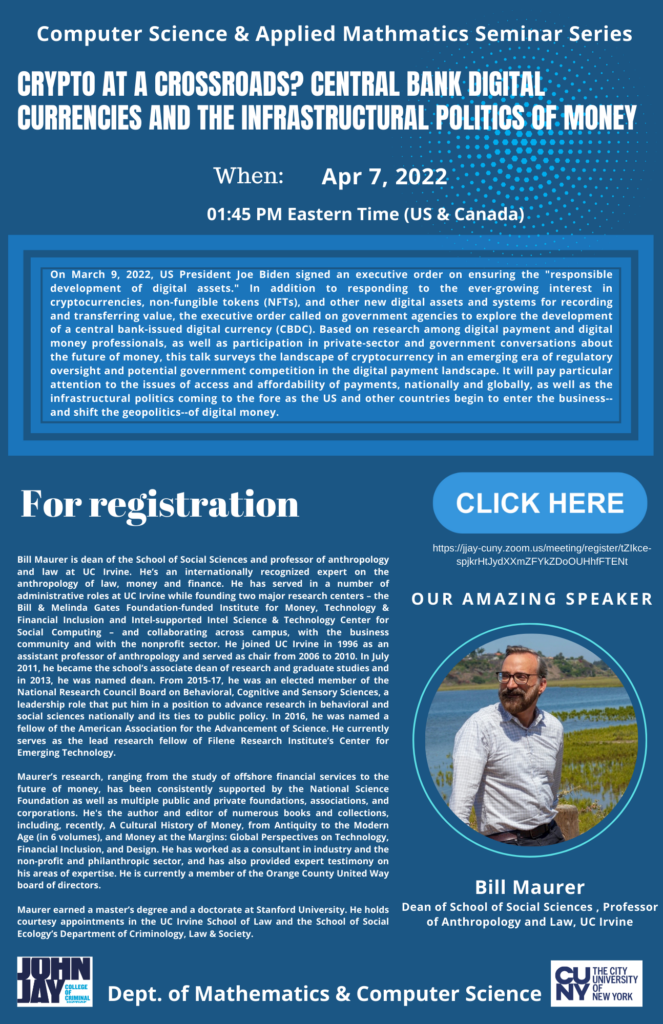Shubham Jain

Abstract
Bio
Omar Chowdhury

Date and Time: 5/10/23 1:40 PM
Register Here!
Abstract
Bio
Michalis Polychronakis
Date and Time: March 28, 2023 1:45pm
Abstract
The exploitation of memory corruption vulnerabilities in popular software is among the leading causes of full system compromise and malware infection. At the same time, the leakage of sensitive data through the exploitation of memory disclosure vulnerabilities is becoming an increasingly important threat. To make matters worse, the threat of data leakage has been exacerbated by the recent spate of transient execution attacks, which can leak otherwise inaccessible process data through residual microarchitectural side effects. In this talk I will present our work on software specialization, the goal of which is to restrict the operations an attacker can perform as part of vulnerability exploitation, and on selective data protection, which prevents data leakage attacks by protecting sensitive user data in memory.
Bio
Michalis Polychronakis is an associate professor in the Computer Science Department at Stony Brook University. He received the BSc (’03), MSc (’05), and PhD (’09) degrees in Computer Science from the University of Crete, Greece, while working as a research assistant in the Distributed Computing Systems Lab at FORTH-ICS. Before joining Stony Brook, he was an associate research scientist at Columbia University. His research aims to improve the security of computer systems and networks, build defenses against malicious software and online threats, reinforce the privacy of our online interactions, and enhance our understanding of the internet and its darker sides. He has published more than 100 peer-reviewed papers, many of them in top venues such as IEEE S&P, USENIX Security, ACM CCS, ISOC NDSS, EuroSys, and USENIX ATC, and is the recipient of the DARPA Young Faculty Award and the NSF CAREER Award.
Everything You Always Wanted to Know About Fingerprinting Browser Extensions, But Were Afraid to Ask – Prof. Nick Nikiforakis
When: Nov 15, 2022 01:45 PM Indiana (East)
Abstract
More and more users are finding out about browser fingerprinting and how trackers can use it to supplement or altogether replace cookie-based tracking. In this talk, we will explore the landscape of a specific kind of browser fingerprinting, namely browser-extension fingerprinting. Since users explicitly choose which extensions to install, the discovery of a user’s extensions can reveal sensitive socioeconomic properties about that user, such as, their level of income, their political leanings, their technical expertise, and even their religion. Moreover, since different users install different sets of browser extensions, the set of extension of a given user can be straightforwardly turned into that user’s fingerprint. We will go over the different techniques that are available for fingerprinting browser extensions (including web-accessible resources, DOM modifications, stylesheet hijacking) and what modern browsers are doing in order to protect their users against fingerprinting.
Bio
Dr. Nick Nikiforakis (PhD’13) is an Associate Professor in the Department of Computer Science at Stony Brook University. He leads the PragSec Lab, where his students conduct research in cyber security, with a focus on web security, web privacy, DNS security, attack-surface reduction, and deception-based security. He is the author of more than 70 peer-reviewed academic publications and his work is cited over 4,700 times. He is the recipient of the National Science Foundation CAREER award (2020), the Office of Naval Research Young Investigator Award (2020), as well as a range of other security-related and privacy-related awards by federal funding agencies.
Is the Mobile Web Experience Improving? – Prof. Aruna Balasubramanian
Oct 5, 2022, 1:45pm to 3pm
Abstract: There is no question that mobile browsers are critical to how users access Internet content today. The question is, is mobile Web performance improving? If so, is the improvement equitable? Our study find that lower-end phones that are popular in emerging countries see considerably worse Web performance compared to its higher end counterpart. In effect, users who do not wish (or cannot afford) to constantly upgrade their devices are experiencing a slower web. Among the higher-end phones, the overall performance appears to be improving in terms of traditional Web metrics. However, these metrics do not take into account user experience. I will discuss the work in our lab to address both of these issues.
Bio: Aruna Balasubramanian is an Associate Professor at Stony Brook University. She works in the area of networked systems. Her current work consists of two threads: (1) significantly improving Quality of Experience of Internet applications, and (2) improving the usability, accessibility, and privacy of mobile systems. She is the recipient of the SIGMobile Rockstar award, a Ubicomp best paper award, a VMWare Early Career award, several Google research awards, and the Applied Networking Research Prize. She is passionate about improving the diversity in Computer Science and broadening participation. She leads the diversity committee at Stony Brook and is the faculty advisor of the Women in Computer Science (WiCS) and the WPhD group at Stony Brook.
Microsoft Azure AI solutions and Industry Accelerators – David Waxman
Date and Time: September 28, 2022, 1:45 pm
Speaker:
David Waxman, Worldwide Director of Defence and Intelligence Industry Solutions, Microsoft
Abstract:
Microsoft is investing in making their software and cognitive services easier to use and easier to deploy. They are creating “Industry Accelerators” which are code, documentation and education aligned to mission use cases, saving customers and partners time and money, accelerating the overall “time to value” in using Azure. This demonstration will feature two of those industry accelerators.
MINTED – The Multi Intelligence Enabled Discovery (MINTED) Industry Accelerator has been designed to support the “Digital Evidence / Captured Enemy Materials” use case. MINTED enables organizations to discover and prioritize time sensitive data with Microsoft AI. Encompassing digital media enrichment, supervised and unsupervised ML models, rules-based alerting, overhead imagery pattern recognition, and automated trade craft for multi-source anomaly detection to increase productivity and increase the speed of intelligence analysis.
Tactical AI: Offline – The Tactical AI: Offline Concept Demonstrator was created to demonstrate the ability to take AI to the “edge”. It is designed to recognize objects on a live video feed and function without any form of external communications. The demonstration illustrates the full life cycle from model creation, training evaluation and through to deployment and operation, outlining how Azure IOT and Azure cognitive services can be combined to address key mission requirements for operators “at the edge”.
Speaker’s Bio:
David has over 25 years extensive technical and operational experience having served with the US Navy and national security organisations. In recent years he has led the design and deployment of Intelligence systems around the world. He has extensive experience in applying emerging technologies (such as Artificial Intelligence) to the challenges related to intelligence systems, rapid information analysis and dissemination. David has worked closely with the defense and intelligence organizations from each of the five eyes (Australia, Canada, New Zealand, United Kingdom and USA) countries.
CUNY High Performance Computing Center – a core research facility for CUNY by Dr. Alexander Tzanov
Abstract
The CUNY-HPCC was created in 2008 and quickly become core research facility at the University. The center supports mixture of architectures (SMP, DSM, Clusters) all integrated together and thus supporting wide variety of research activities. The center implements advanced job management system (beyond basic batch system) systems which analyzes jobs and places them optimally in terms of resource utilization and jobs throughput. In this presentation we will discuss the High Productivity Computing (HPrC) as it is implemented at CUNY-HPCC especially the support for multi scale simulations. Indeed, most mathematical operations do have some degree of parallelism – from perfect mathematical parallelism when no dependencies among the different pairs of data exist, to partial parallelism which incorporates interdependencies. On other hand the modern HPC systems offer several levels of parallelism from CPU based parallelism to system defined parallelism to SIMT parallelism of graphics processing units (GPUs). In that sense we will discuss the different programming models supported by CUNY-HPCC, tools, job and data management, application management and user support and analytics as core elements of HPrC at CUNY.
Bio
Dr. Tzanov is the Director of CUNY High Performance Computing Center at College of Staten Island. His background is in Applied Physics and Electronics, Environmental Science, Computer Science and Computational Chemistry. He worked as tenured faculty at Departments of Computer Science at Technical University of Sofia and at Queens University of Belfast (UK) and as visiting professor at Buckingham University (UK). He is also assistant professor of professional practice at Rutgers University. He did his post doc with Prof. Barry Honig at Columbia University (1998-2001) working on developing novel methods for protein structure prediction. His PhD is in Computational Chemistry at New York University. He worked at NYU HPC division and at Department of Chemistry at New York University for more than 13 years before moving to CUNY-HPCC in 2013. His theoretical research interest is in development of enhanced sampling methodologies for the field of Computational Chemistry and Materials Science, AI in Chemistry and Physics, Scientific High Performance Computing and scalable numerical algorithms.






